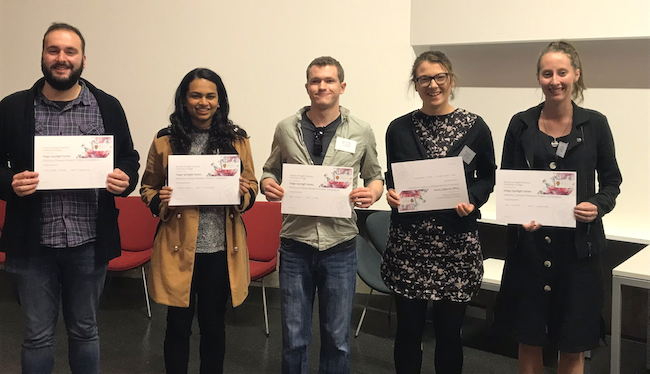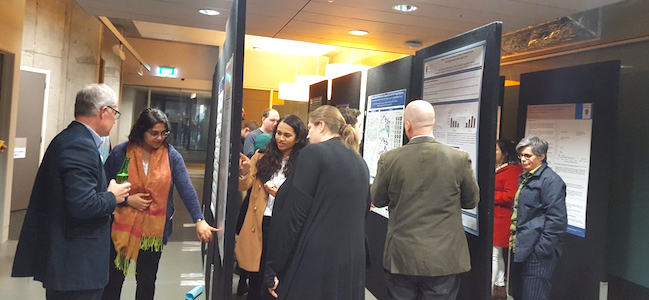Thursday 13 September 2018 1:21pm

From left prizewinners: Chris Kaldor, Aarthi Rajesh, Brin Ryder (first prize), Serin Cooper Maidlow, and Zoe Williams.
Brin Ryder, Department of Microbiology and Immunology, won the 2018 Otago Spotlight student poster competition. As one of five finalists he presented his work, on early immune response, to a large audience at the Infectious Disease research forum in Wellington, and was awarded first place by the judges.
Congratulations to Brin, fellow prize winners, and contestants!
Read the abstracts of the prizewinners' research below.
Brin Ryder
BCG immunisation alters lung phagocyte dynamics during early mycobacterial infection of mice
- B Ryder, Department of Microbiology and Immunology, School of Biomedical Sciences, University of Otago, Dunedin
- S Wiles, Bioluminescent Superbugs Lab, Department of Molecular Medicine and Pathology, University of Auckland
- J Kirman, Department of Microbiology and Immunology, School of Biomedical Sciences, University of Otago, Dunedin
Tuberculosis (TB) causes more deaths than any other infectious disease. In adults, protection by the TB vaccine Mycobacterium bovis bacille Calmette-Guérin (BCG), is highly variable. Efforts to develop an improved vaccine have been hampered by poor understanding of the early immune response and how immunisation generates protective immunity. Particularly, it has not been verified which immune cells take up mycobacteria during early infection. Using multiparametric flow cytometry and fluorescent mycobacteria to model lung infection in mice, we described lung immune cells during the initial days of infection.
Prevailing dogma assumes lung macrophages are the main immune cells that take up mycobacteria during early infection; surprisingly, we found only 9% of infected cells were lung macrophages at one day post-infection. By contrast, circulating neutrophils rapidly accumulated in the lungs and comprised the majority of infected cells one day post-infection.
It was previously undetermined how BCG immunisation influences early events of infection. The immune response to mycobacteria was altered in immunised mice, including pre-activation of lung macrophages before infection, and reduced neutrophil recruitment one day post-infection. Restricting neutrophil infiltration through immunisation may limit detrimental inflammation during early infection. In combination, these alterations may explain some of the enhanced bacterial control provided by BCG immunisation.
Our data present the first evidence of neutrophils as the primary infected immune cells early after mycobacterial infection. Further, we demonstrate how the early immune response is modulated by immunisation. These insights provide a foundation for targeting specific elements of innate immunity to enhance vaccine development.
This work was supported by the HS & JC Anderson Charitable Trust, Webster Centre for Infectious Diseases, and University of Otago Division of Health Sciences.
Chris Kaldor
Streptococcus pneumoniae adhered to neutrophil extracellular traps produce hydrogen peroxide which is converted into hypochlorous acid
- Christopher D Kaldor, Centre for Free Radical Research, Department of Pathology, University of Otago, Christchurch
- Heather Parker, Centre for Free Radical Research, Department of Pathology, University of Otago, Christchurch
- Greg Cook, Department of Microbiology and Immunology, School of Biomedical Sciences, University of Otago, Dunedin
- Mark Hampton, Centre for Free Radical Research, Department of Pathology, University of Otago, Christchurch
Streptococcus pneumoniae produce hydrogen peroxide as part of their normal metabolism. This has been shown to damage lung cells and contribute to the inflammation seen in pneumonia, and S. pneumoniae are the leading cause of community-acquired pneumonia. Whether they continue to produce hydrogen peroxide while interacting with host immune cells, and what downstream oxidants are produced from their hydrogen peroxide has not yet been studied extensively.
This research looked at myeloperoxidase, an enzyme found on neutrophil extracellular traps (NETs) and whether it can turn hydrogen peroxide into other bactericidal oxidants.
NETs are chromatin structures released by stimulated neutrophils and have been shown to capture S. pneumoniae and many other pathogens associated with pneumonia. Fresh neutrophils were taken from healthy volunteers and stimulated to form NETs, and then co-incubated with S. pneumoniae clinical isolates. Hydrogen peroxide production was measured, and then hypochlorous and thiocyanic acid concentrations were measured, as these are two oxidants that myeloperoxidase can make from hydrogen peroxide.
It was found that S. pneumoniae continue to produce hydrogen peroxide at a similar rate when free or adhered to NETs, although not all of this is converted into hypochlorous and thiocyanic acid. Future work will investigate how these oxidants generated affect neighbouring cells.
Aarthi Rajesh
Investigating the role of Langerhans cell during wound healing
- Aarthi Rajesh, Department of Pathology, Dunedin School of Medicine, University of Otago, Dunedin
- Nicola Jones, Department of Pharmacology and Toxicology, School of Biomedical Sciences, University of Otago, Dunedin
- Gabriella Stuart, Department of Pharmacology and Toxicology, School of Biomedical Sciences, University of Otago, Dunedin
- Heather Cunliffe, Department of Pathology, Dunedin School of Medicine, University of Otago, Dunedin
- Lyn Wise, Department of Pharmacology and Toxicology, School of Biomedical Sciences, University of Otago, Dunedin
- Merilyn Hibma, Department of Pathology, Dunedin School of Medicine, University of Otago, Dunedin
Chronic wound infections are responsible for considerable morbidity and mortality worldwide. The microbiology of chronic wounds is complex making it very challenging to treat. Langerhans cells (LC) are a subset of epidermal dendritic cells, which are one of the first cells of the immunological barrier. In this study, we investigate the role of LC in the regulation of wound healing.
LangDTR mice transgenic for the Diphtheria Toxin (DT) receptor under the control of a langerin/CD207+ promoter were used in this study, allowing for the selective ablation of LC upon treatment with DT. Wounding was compared between mice with (LC+) or without (LC-). Histological analysis was carried out to assess phenotypic changes between the two groups.
A comparison of the wounds between LC+ and LC- groups revealed that wound healing was more rapid in the absence of LC with increased re epithelialization mice at days 3 and 6-post wounding. Proliferating cell nuclear antigen (PCNA) immunofluorescence (IF) staining was carried out to confirm if the increased re epithelialization was mediated by keratinocyte proliferation but no significant difference was observed. There was two-fold increase in angiogenesis in the absence of LC at day 6 confirmed by both MSB and IF staining.
In conclusion, LCs are involved in delaying wound healing, which may be contributed to by suppression of re epithelialization and angiogenesis. Results from this study could be extrapolated for the management of chronic wound infections where slower healing due to reduced re epithelialization and angiogenesis is observed.
Serin Cooper Maidlow
Reasons for non-compliance with Community Acquired Pneumonia clinical guidelines
- Dr Serin Cooper Maidlow, BMBS, PGCert, Masters student, University of Otago, Christchurch. Medical trainee, Canterbury District Health Board
- Professor Michael Ardagh, Professor of Emergency Medicine, University of Otago Christchurch. Emergency Medicine Specialist and Clinical Lead for Hospital HealthPathways, Canterbury District Health Board
Clinical guidelines reduce variation in practice between clinicians and promote consistent, streamlined care. Compliance rates with clinical guidelines, however, are generally reported to be poor. Community Acquired Pneumonia (CAP) guidelines recommend empirical antibiotics based on internationally recognised risk stratification tools, e.g. CURB-65 scoring, local sensitivities, and epidemiology in order to adequately treat patients while maintaining responsible antimicrobial stewardship.
A prospective study was carried out over a 100 day period (February - May 2018). Data was collected on cases of CAP assessed in Christchurch Hospital, and doctors diagnosing each case were interviewed regarding management choices.
47% of the patients within the study population received antibiotics which were compliant with the hospital's CAP clinical guidelines. Reasons for non-compliance were categorised into four larger groups. 55% of reasons for non-compliance given by the doctors interviewed were 'Objective' reasons; 21% were 'Subjective' reasons; 8% of doctors did not comply with the guidelines due to 'Disagreement' with the recommendations; and 16% 'Did not follow' the guidelines for other reasons such as mistakes or confusion.
By exploring the reasons for non-compliance with clinical guidelines in specific cases, common reasons why clinical guidelines are not followed can be addressed and this information can be used to improve clinical guidelines.
Zoe Williams
Prize sponsored by the Otago Medical School Research Society
Next generation inhibitors to combat drug resistant tuberculosis infections
- Zoe Williams, Department of Microbiology and Immunology, University of Otago
- Xiaoyun Li, School of Pharmaceutical Sciences, Jinan University, Guangzhou, China
- Ke Ding, School of Pharmaceutical Sciences, Jinan University, Guangzhou, and Chinese Academy of Sciences, China
- Gregory M. Cook, Department of Microbiology and Immunology, University of Otago, and Maurice Wilkins Centre for Molecular Biodiscovery, The University of Auckland
Tuberculosis remains one of the leading worldwide causes of infectious disease mortality globally with over one million annual deaths. The emergence of extensively drug-resistant, and totally drug-resistant strains of Mycobacterium tuberculosis, threatens to return us to the pre-antibiotic era for this disease.
The discovery of the imidazopyridine amide series (e.g. Q203), nanomolar inhibitors currently in clinical trials that inhibit mycobacterial respiration, has sparked interest in the targeting of terminal respiratory oxidases to treat drug-resistant TB disease1. Mycobacteria are obligate aerobes and respire using two terminal respiratory oxidases, a cytochrome bc1-aa3-type cytochrome c oxidase (qcrCAB operon – bc1 complex) and a cytochrome bd-type menaquinol oxidase (cydAB operon). Here we report on the mode of action of TB47, a newly synthesized derivative of Q203.
In contrast to Q203, TB47 was cidal against replicating cells of M. tuberculosis. Similar experiments with Mycobacterium smegmatis revealed that TB47 was only static against wild-type cells. TB47 inhibited respiration of the ∆cydAB mutant but was without effect on wild-type cells. TB47 dissipated the delta pH gradient in energized membrane vesicles of M. smegmatis. Spontaneous mutants resistant to TB47 could be isolated in the ∆cydAB background. Whole genome sequencing of these mutants mapped the mutations to the QcrB (H190Y), the cytochrome b subunit of the cytochrome bc1 complex. Respiration of the QcrB mutant was not inhibited by TB47. Taken together these data demonstrate that TB47 targets the QcrB subunit of the cytochrome bc1-aa3-type cytochrome c oxidase at residue 190 of QcrB leading to accelerated cell death in the ∆cydAB mutant.
1.Pethe, K., Bifani, P., Jang, J., Kang, S., Park, S., Ahn, S., Jiricek, J., Jung, J., Jeon, H.K., Cechetto, J. and Christophe, T., 2013. Discovery of Q203, a potent clinical candidate for the treatment of tuberculosis. Nature medicine, 19(9), pp.1157-1160.
2.Kalia, N. P., Hasenoehrl, E. J., Ab Rahman, N. B., Koh, V. H., Ang, M. L., Sajorda, D. R., ... & Berney, M. (2017). Exploiting the synthetic lethality between terminal respiratory oxidases to kill Mycobacterium tuberculosis and clear host infection. Proceedings of the National Academy of Sciences, 201706139.
Other contestants
Read about other contestants entries in our programme:
Otago Spotlight Series: Infectious Disease Research programme (PDF 2.1 MB)

Students, judges and guests view the competitors research posters at University of Otago, Wellington campus.
